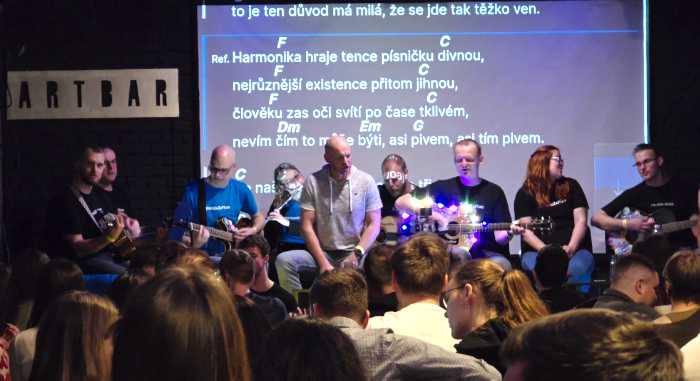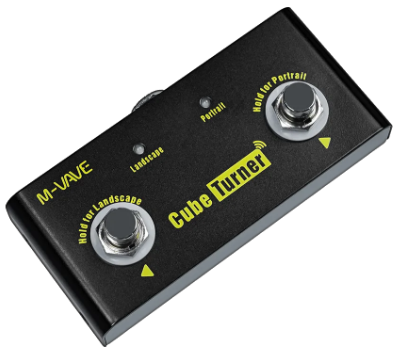Table of Contents
Text Format and Appearance 🎨
Songs are written in a primitive markup language so you don't have to deal with text formatting, color variations, fonts, size adjustments, and more 🙂.
The resulting format has been proven in practice across hundreds of music events and many devices – whether on desktop computers 💻, phones 🤳, tablets 🪟, or projectors 📽️. Last but not least, the Kytario songbook is designed for use in printed form in A5 format.
You cannot change the color, font, or any other text attributes. If you still need to visually distinguish certain parts of the text, consider using one of the many UTF-8 symbols or emoji 😅. There are no limits to creativity.
Layout Types
The Kytario songbook is adapted for both mobile and desktop devices as well as projectors. This allows you to choose whether you want to see the entire song (at the cost of smaller text) or enlarged (at the cost of having to manually scroll the song). 💡
The layout mode can be toggled by expanding the bottom menu, which is displayed for songbooks and songs.
Two-Column Layout 💻
The two-column, or "desktop" layout, is the default layout that allows you to read the entire song without scrolling. This layout is also used for printing the songbook to PDF 🖨️.
Provided it's written that way in the song, certain elements are hidden in the two-column layout, which makes it possible to display the entire song on one page. An example is the song Snow - Red Hot Chili Peppers, which contains many repeating chords and sections. These, although written in the song, are hidden in this layout 👻.
The two-column layout is automatically displayed when the device displaying the songbook is oriented "landscape" (the top of the display is its longer side) and it's not a mobile device.
Single-Column Layout 📱
The single-column, or "mobile" layout, is primarily intended for situations where better text readability is needed. Although we often call this layout "mobile," we recommend using it for projection as well - even a standard projector with a smaller screen will allow people sitting far from the screen to read the text with this layout. 👁️
In this layout, all parts of the song are always displayed, and all repeating parts of the song are fully rendered in the text. In the case of the song Snow - Red Hot Chili Peppers, these are sections like Ref1 - Brid. - Ref2 - Ref3.
The single-column layout is automatically displayed on mobile devices, or when the device is oriented "portrait" (the top of the display is its shorter side).

LIVE Mode 🎥
A key feature of the Kytario songbook is the ability to centrally control the displayed song on all other devices. This mode allows you to select the displayed song, transpose it, scroll it, and optionally display a pop-up message. 📢
To control a songbook, you need to have editor or administrator permissions for the project it belongs to. If you want to control a songbook that isn't yours, you can easily copy it using the button in the dropdown menu in the songbook list and then control this newly created copy.
💡 If you're organizing a larger event, it's a good idea to share the songbook QR code with people (which can be displayed using the button in the dropdown menu in the songbook list). It's the easiest way for people to access the songbook, as they won't have to manually search for it in the entire list, where mistakes can easily happen.
Basic Mode (song selection) 🚦
Are you organizing a small event with friends, or playing somewhere with a large projection screen that can fit the entire song? Here, the "basic live mode" will suffice - in it, you can easily select a song that will then be displayed on all connected devices. 💪
Simply open your songbook, display any song, and click the "Set live" button. This will display this song on all other devices as well. If you switch to another song, you need to press the "Set live" button again to display this song to others as well. 🎉
If you want to turn off live mode and allow people to browse the songbook more easily, just display the song list and click the "Turn off live mode" button. It will also automatically turn off after 8 hours of inactivity. 💤
If live mode is already on and someone else opens such a songbook, their device will automatically follow the selected song. Pressing the red Live 🔴 button will "disconnect" from this mode and allow free browsing of the songbook.
You can also transpose the song using the buttons in the bottom menu, and confirm this transposition again using the "Set live" button to display it to others. 🔝
Advanced Mode (scrolling songs) ⏬
Want to get the most out of Kytario and make it easier for fellow musicians and singers to navigate the lyrics? Kytario offers the ability to remotely scroll the displayed song! This scrolling is controlled by one of the players and allows others to display the songbook in single-column layout so that they don't have to scroll the screen manually at all. It's a feature that people around you will definitely love ❤️
Scrolling can be controlled in three ways:
- Using the up and down arrows in the bottom right corner of the screen,
- using the mechanical up/down arrow keys on your laptop/PC keyboard, or
- using any device that emulates the up and down arrow keys.
For scrolling, the songbook (for all users) must be displayed in single-column layout (see Layout Types), live mode must be on and a song must be selected (see Basic Mode (song selection)). Additionally, on the device controlling the songbook, you need to turn on "scroll mode" using the green "Turn on scroll mode" 🟩 button in the songbook dropdown menu.
If this is met, clicking the down arrow on the display, keyboard, or external device will highlight the first section of the song, and each subsequent click will highlight the following section. The up arrow has the opposite effect. 🤖
If you have a playlist selected (in the bottom dropdown menu), buttons for the next song from the playlist will appear at the end of the song. This button can be highlighted just like other sections, and the next press of the down arrow will switch the displayed song. With a playlist, you just keep pressing the down arrow throughout the event and don't have to worry about anything else 😉.
M-VAVE Cube Turner "Page Turner"
Of all the devices for controlling song scrolling, the M-VAVE Cube Turner has worked best for us. It's a device based on a wireless Bluetooth keyboard that can be connected to a laptop, tablet, or phone. The built-in battery lasts over 10 hours, USB-C charging, metal chassis. The buttons have strong mechanical and audible feedback, which provides confidence in switching. All this for approximately 500 CZK from Aliexpress or similar stores.

Questions you might have:
- How to use the M-VAVE Cube Turner "page turner"?
- Scrolling doesn't work or is stuttering. What to do?
- What alternatives exist for songbook scrolling?
- Is it possible to scroll only part of a section? A section (verse/chorus) doesn't fit on my display entirely.
- Is it possible for multiple people to control the songbook at once?
- Why is single-column layout necessary for scroll mode?
- Is it possible for the songbook to scroll automatically?
Pop-up Message Window 💬
Want to play a song from someone else's songbook or another website, or just tell people what you think of them? 😆 Live mode offers the ability to display a message in a pop-up window. Simply type this message in the field in the songbook's bottom dropdown menu and confirm (either with enter or the green button 🟩). The message will be displayed on all devices. With the red X ❌, you can then hide this message from everyone.
You can also insert links to other websites in the message, which is useful mainly for playing songs outside Kytario. You no longer have to tell people to manually search for the song 🙂 (because there's always at least one expert who will open a different version of the same song 🤣).
Writing Songs 📝
Writing songs follows several rules that must be followed for the text to be rendered correctly. The notation consists of several parts:
- Chords (
{Em}) - Fixed Spaces (
{---}) - Sections (
- Ref.) - Section References (
[Ref.]) - Repetitions (
|: Ha :|)
If you're looking for inspiration on how to write songs efficiently, check out the KytarovkyBrno songbook, from which this entire platform emerged 🙂.
Chords
Chord Formatting
Chords are written in curly braces, e.g. {C}, {Em}, or {C#m7}. The chord tone designation (first character) must always be a capital letter. Chords can also be compound, e.g. {F#m7/G#}, with the tone after the slash indicating the bass tone.
The chord nomenclature you choose is entirely up to you. You can write in the "American" form (e.g. {Emi} - e minor) or Latin ({Em} - e moll). However, due to inconsistencies in chords from various sources, we recommend Latin nomenclature.
💡 Simplicity is strength – if you're writing songs for a wide audience and it's not one that's built on complex chords, we recommend simplifying chords as much as possible.
Chord Position
Chords should be positioned in the notation to precede the word (or letter) they belong to, e.g.:
{A}Na našem {Amaj}rybníku, tam v {A7}ráji řas a vodníků.
If you need to write multiple chords within one word, you can split the word with one or more hyphens, e.g.:
{Em}Má - {G}á - {D}á.
If a chord is played in a part where there's no text, you can offset it with a space on both sides. This will stretch the text around it, e.g.:
{E}Zdá se {F#m}mi, {G#m} je to {F#m}moc let,.
Without this offset, the chord {G#m} would be rendered above the word je.
Fixed Spaces
If there's a situation where you need to offset part of the text where there's no chord, you can insert a fixed space into the text. There are 3 different widths of this space, and you can also chain them:
- short:
{-} - medium:
{--} - long:
{---}
💡 Use fixed spaces only in exceptional cases. Ideally, spaces in the text are created by writing a chord surrounded by regular spaces.
Sections
Songs consist of sections – verses, choruses, interludes, and others.
Named Sections
Each section containing sung text must be named somehow, either with a number or word.
Names should not be longer than 4 characters and must always start with a minus sign (- Ref1) or plus sign (+ Ref2).
The difference between these two variants is that sections introduced with a minus symbol always display chords – in desktop layout, in print, and on phones. Sections introduced with a plus symbol display chords only in mobile (single-column) layout.
Names can be arbitrary, but we recommend using these:
- Mark verses as
- 1.,- 2., etc. - Mark choruses as
- Ref.,- Ref1, etc. - Mark interludes as
- Brid,- Solo, etc.
Unnamed Sections
If a section has no name, its text is not displayed, only chords.
Such a section can additionally contain references to other sections or repetition, e.g.: |: [Ref.][1.][2.] :|
Unnamed sections can have multiple lines and can chain chords, e.g.:
|: [Ref.][1.][2.] :|
[Solo]
|: {C}{D}{Em} :|
[Ref.]
All elements of unnamed sections are automatically interspersed with dashes for better readability. The example above will therefore be rendered as:
|: Ref. - 1. - 2. :|
Solo
|: C - D - Em :|
Ref.
💡 For interludes, solos, intros, and outros, we recommend leaving the section unnamed. From context, it's clear to people that it's probably a solo when there are several chords without text in the middle of the song. This reduces the amount of information on the page.
Section References
If a song is too long or sections (e.g., choruses) repeat frequently, it's appropriate to write the section in full only once and reference subsequent occurrences.
Section references are written in square brackets and must contain the entire section name without the introductory character (plus/minus), e.g. [Ref.].
If we have a section:
- Ref.
|: Ja som {F#m}malá Žužu{D}žu, toto {E}je môj mikro{C#m}fón.
Ak mi {F#m}dáte svoj do{D}lár, ja vám {E}zaspievam svoj {C#m}song. :|
we can therefore reference it in any unnamed section using [Ref.].
We can wrap these references in repetition and chain them arbitrarily, e.g.: |: [Ref.][1.][2.] :|. In desktop layout and print, references (and chords) will be interspersed with dashes for better readability, and will therefore be rendered as |: Ref. - 1. - 2. :|. In mobile layout, section references are "expanded" and instead of the reference, the entire content of the given section is rendered. This means there's no need to manually scroll the display to find how that section is played.
Repetitions
Repetitions can be written using the characters |: and :|. Repetitions can span multiple lines of text, but must always stay within one section.
If the repetition doesn't indicate the number of repetitions, it can be assumed it will repeat once. If you intend to repeat a passage multiple times, write the number of repetitions after the end of the repetition as 3x, 4x, etc., for example:
|: Dáme si to ještě jednou :| 4x.
Any other notation, although it may look graphically similar (e.g., using slashes / and \), is not supported by the system, and repetitions won't be properly expanded.
If a repetition contains a reference to another section and the songbook is displayed in mobile layout, the content of this section will be rendered below. These notations are therefore equivalent:
|: [Ref.][1.][2.] :|
[Ref.][1.][2.] [Ref.][1.][2.].
💡 Repeated parts of songs often contain only minor changes - changing one word or modified phrasing. If you want to simplify the song, instead of two different versions of this part, write just one and put it in repetition. 😉

